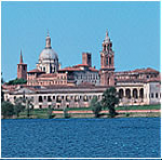Mythology, tradition and historical events are interwoven enchantingly when we talk about Mantova.
Tradition has it that the city, whose name derives from the infernal divinity Mantus, was founded by the Etruscans in the sixth century B.C.
From that moment on numerous events and two dynasties have marked its history over the centuries. Mantova was first subjected to Roman domination, a period illuminated by Virgil, born a few kilometers from the city in 70 A.D. Then, following the fall of the Western Roman Empire (476 A.D.) it was the turn of the barbarian invasions and domination by the various Goths, Byzantines, Lombards and the French.
Towards the year one thousand it became part of the immense feudal territory of the Canossa family whose last representative was Countess Matilda, who died in 1115 in Bondeno di Roncore in the Mantova area.
Then followed government by local authority which lasted until the Bonacolsi family came to power, followed by the Gonzaga family who ruled from 1328 to 1707.
On that date Mantova became part of the Austro-Hungarian Empire, which made it one of the capitals of the Quadrilateral formed by the fortresses of Peschiera, Verona, Legnago and Mantova.
The city became part of the newly united Italian state in 1866.
 |
 |
